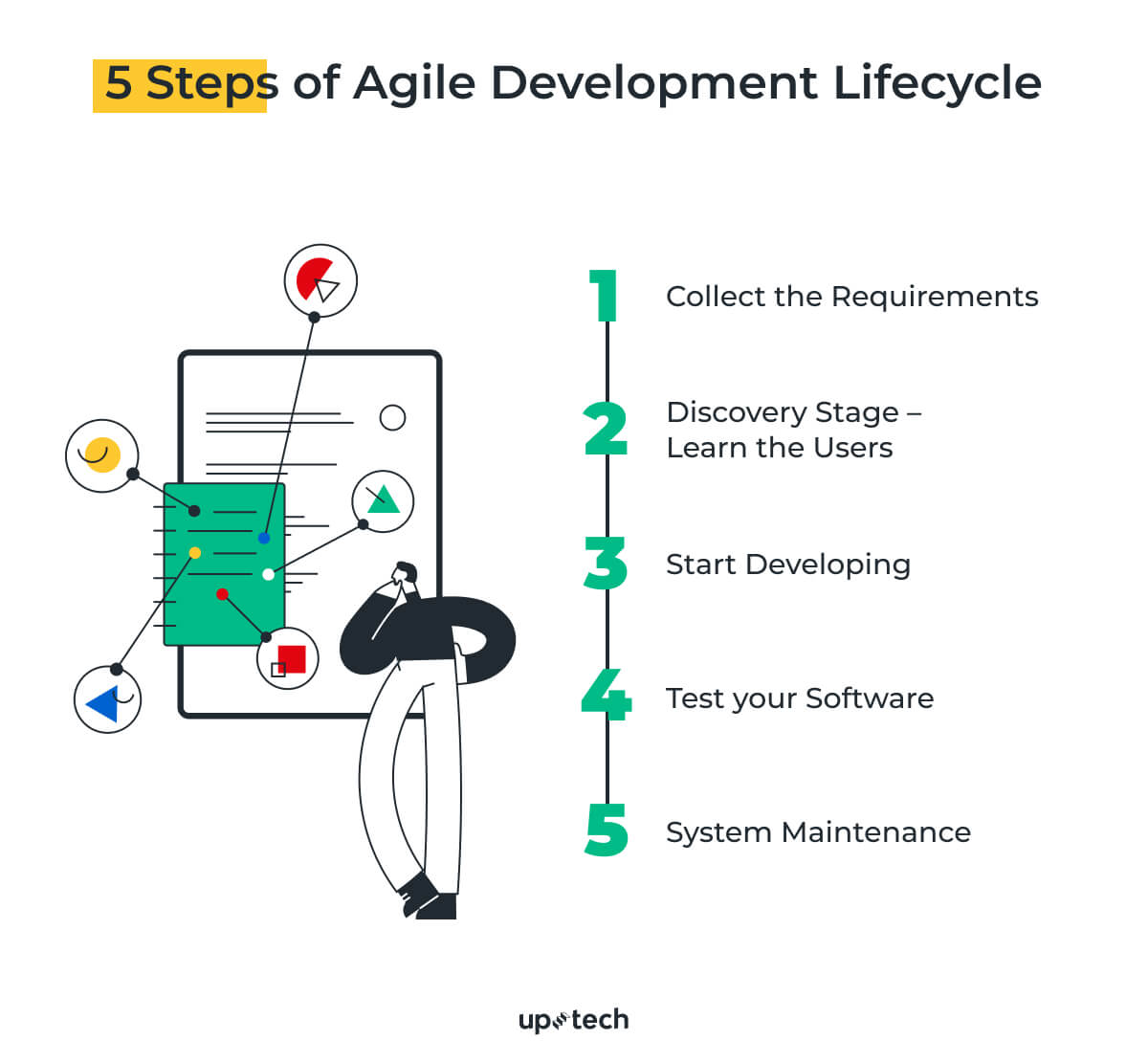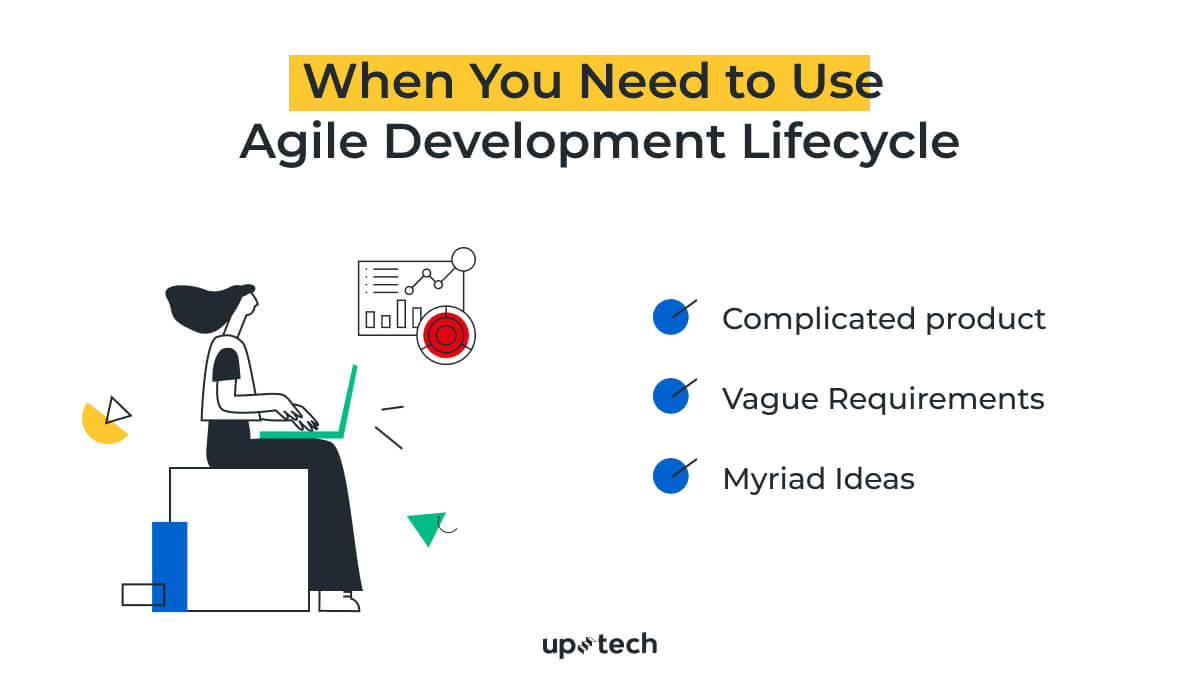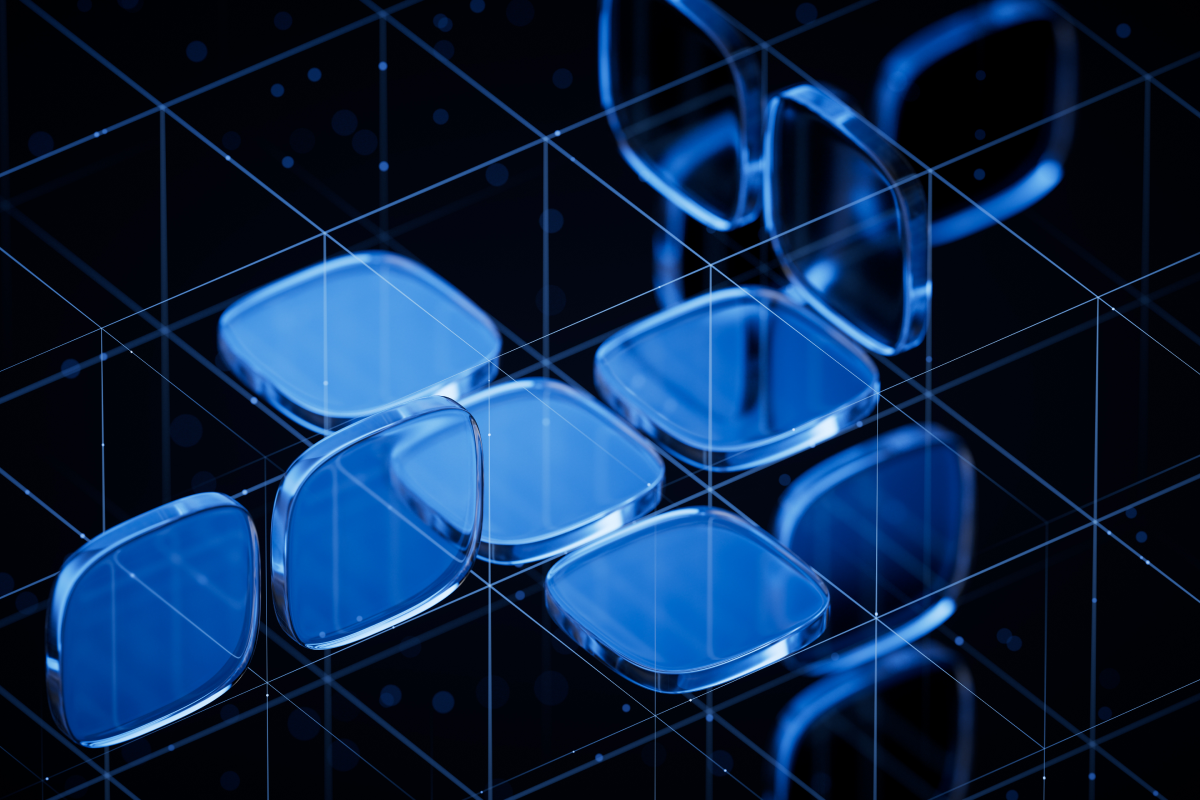If you have ever googled something about project management or software development cycles, you might have heard about Agile development lifecycle. It is hardly surprising, as Agile is the methodology of the moment. With 94 percent of the organizations practicing Agile SDLC in 2016, it has become the industry standard for project management.
I've spent over 3 years as a Project Manager at Uptech, where I focus on delivering successful project outcomes to clients. My expertise in Agile methodologies allows me to prioritize features, mitigate risks, and ensure projects align with client needs.
I know from experience how an Agile software development life cycle can maximize project results when it’s done right.
In this post, I will share the benefits of Agile software development lifecycles, explain where this system came from, and how we at Uptech use it step-by-step.
What is Agile Development Lifecycle?
Agile development lifecycle is the sequence of development phases and methodologies that help to build a product that meets user needs and brings value to their lives.
The name “Agile” speaks for itself and describes the approach to such development. Thus, the main characteristics of Agile software development lifecycle are flexible approach, progress by small parts, cross-functional teams and high team involvement. Among the top IT companies using Agile SDLC, you can find:
- Cisco
- LEGO Digital Solutions
- Barclays
- Ericsson
- John Deere
- Royal Philips
Moreover, the Agile product development life cycle is not limited to IT. According to Capterra report, Agile development cycle is now the leading project management methodology in such industries:
- Financial services;
- AEC;
- Education;
- Manufacturing;
- Healthcare services
- Entertainment;
- Retail.
In 2020 the percentage of Agile adoption in software development was just 37%. In comparison to that, in 2021 this number has already reached 86%.
Agile Mindset in Principles
Agile development lifecycle is entirely human-centered, aspiring to adapt and deliver joy to both users and the development team. This approach is implemented via self-organizing, cross-functional teams utilizing the appropriate practices for their context.
Besides, people are very adaptable and capable of making changes, making swift decisions, getting back or even changing tracks if needed, and taking full responsibility for their work. The flexibility and swift decision-making skill form the core of Agile development lifecycle.

Let’s look at the core principles of Agile development methodology:
- Flexibility. Agile proclaims that the poise for changes is way more valuable than following a definite algorithm every time;
- Work breakdown. The team does not build the whole product at once. Instead, the project is divided into small cycles;
- Value of teamwork. People are more valuable than processes and docs. It is important that the team works together and shares a common vision of the end result;
- Iterative improvements. The product is developed and tested by iterations. At each one, new features are added, and the functionality is updated every time;
- Client as a part of the team. The client is entirely involved in the product development and offers ideas that are further validated and tested;
- Product comes first. Agile development aims to build a great product and is not focused on documentation and processes.
To summarize, teams that follow the Agile software development life cycleavoid strict formalization of product requirements, but double down on the product itself, people, and agile collaboration. This step in software development is revolutionary, in how a product is built.
How Development Lifecycle Worked Before Agile
Let’s take a look at how the development lifecycle used to take place before Agile was invented. The client would approach the development company with an idea in mind and a list of paper requirements. The team would indifferently take this idea, break it down into software requirements, make intuitive UX design, and start coding the entire software at once. Once tested and fixed, the product would be launched.
This software development cycle is called Waterfall or cascade development, as it features the consecutive logical development progress. The advent of Waterfall was a meaningful shift in software development history, as it disciplined the way teams work on the project and collaborate with the client.
For many years, the Waterfall framework has been the only option for development teams to build software. And for this period, it lived up to the expectations, but the industry revved into gear at some point. Now Waterfall is still being used by such big corporations as Gartner for application development.
Today, developers are burdened with more projects and have a shorter time-to-market span. Development companies had to develop a methodology that would allow them to work faster and create a product by parts rather than an entire software.

How Agile Product Development Lifecycle Transformed Development Process
Officially, the Agile software development life cycle dates back to 2001, when a team of software developers on the lookout for an alternative software development framework, came up with the Agile Manifesto. That document reflected the new take on software development that leveraged constant improvement and incremental development.
Some flexible instruments in project management had been used even earlier. In 1957, Bernie Dimsdale, John von Neumann, Herb Jacobs, and Gerald Weinberg turned to the incremental approach (now called Agile) while working for IBM and Motorola. Even at that time, developers realized that Waterfall had a long time-to-market, and swift changes were imminent.
The changes came with app development. As more and more apps are entering the market, the time-to-market timeline needs to get shorter. The pressure of the competition made the market respond with a faster development process. This is how the Agile development lifecycle appeared.
5 Steps of Agile Development Lifecycle
Talking about the Agile product development life cycle, it is worth mentioning that Agile covers a number of methodologies, like:
- SCRUM;
- Kanban;
- DSDM (Dynamic Software Development Method);
- XP (eXtreme Programming).
Below is a step-by-step guide to the most popular methodology – SCRUM. Here are six phases of Agile methodology according to SCRUM:

Below is a step-by-step guide of the most popular methodology – SCRUM. Here are five phases of Agile methodology according to SCRUM:
Step 1. Collect the Requirements
Everything starts with the concept. When the client approaches the company with an idea, the team starts gathering the requirements for the projects. Requirements are the technical and non-tech specifications that define the product’s main functionality and the way it will work. Following that, the requirements are gathered in a file called SRS, which becomes the main document of the project.
Step 2. Learn the Users
When a product is driven by innovation, there is always a risk that its idea will not reach the hearts of users. To eliminate this risk, we carry out a thorough Discovery.
At this stage, we conduct profound research of the market and crystalize who our potential user is. Not only do we define who he/she is, but we also look at their pains, desires and frustrations. To that end, we closely communicate with users via interviews and user tests. Such profound research helps to find the proper solutions that will totally fit the user's needs.
Knowing your users helps us to create the UX flow that would live up to their needs and solve their problems.

Step 3. Start Developing
Once the UX wireframes are ready, it is time to put them into code. At this stage, the development team brings the product to life in the programming language and according to the SRS document. Tasks are assigned to the specialists in the team and divided into modules and units.
Step 4. Test your Software
Here is where the QA part of the project starts. QA teams test the software to unveil possible system bugs by running automated or manual tests. The product cannot be launched until all bugs are found and fixed.
Step 5. Implement and Maintain the Agile Development Lifecycle
Finally, the software is launched. From this moment our team only needs to maintain the system and check out how it works. The team provides the support and fixes the bugs that may come along.
Top 3 Benefits of Agile Product Development Lifecycle
Agile project life cycle is going to boost your software development process. Statistics show that building a strong, agile system in your organization can lead to a higher commercial performance of 237%.
Here are 3 reasons why you should use the Agile development lifecycle instead of the Waterfall approach:

It responds to the modern conditions
In the conditions of high competition, development companies have no choice but to be flexible. Iterative development, user feedback, and tests are Agile software development life cycle instruments, which help to make a product competitive.
Agile encourages improvement
These days it is hard to imagine that Apple or Google would be satisfied with their products at the first iteration. Agile development helps to highlight the points or weaknesses and provide room for constant improvement.
Agile focuses on people
Agile software development lifecycle is focused not only on users but also on the people working on the product. A flexible approach makes people more productive and happier, giving room for creativity and innovation.
How to Work With Remote Agile Teams and Tackle Challenges
Agile product development life cycle is a collaboration system tailored for co-located teams. It involves a lot of communication, spontaneous discussions, and close collaboration.
However, as the world is adapting to the post-pandemic reality and shifts to the remote work format, Agile SDLC bravely takes the challenge.
Here are 3 tips on how to make the Agile lifecycle function in the remote format:
Tip # 1. Use Team Management Tools
A common problem that many teams face while working remotely, is a lack of office space where you could discuss everything on the go, have whiteboards and post-it cards. If you feel that your teams lacks it, discuss it and try using the tools from the list:
- Slack – good for daily communication with the team;
- Jira – a great task-management tool;
- Zoom and Google Meet – tools for video calls;
- Figma – a real-time interface design too;
- Figma Jam– good for real-time teamwork with a whiteboard.
Yet, you should remember that teams should define the work process, not the tools. If you are a manager or a team member, you should work collaboratively on your process improvement so that these processes serve the team goals. You could integrate any processes and use any tools you want if they solve problems for the team. During retrospectives or any other meetings, you could discuss possible improvements and find ways to implement them.
Tip # 2.Keep in touch with the team
For the team to solve problems and achieve the product goals you need sound relationships and clear communication. The agile methodology suggests having regular meetings, particularly:
- Backlog Grooming;
- Planning meetings;
- Daily check-ins;
- Demo;
- Retrospective.
Yet, Agile software development life cycle doesn't limit us to this list. If you feel that your team needs to add something to these processes, feel free to do it (if it is really helping and if you really need a meeting to discuss something).
As an example, while working on Nomad, we had a pretty big team and decided to introduce regular "Technical Synchs" which we used to discuss the technical implementation of the planned features. It helped engineers and other team members to stay on the same page and avoid misunderstandings during the actual development.
Tip # 3.Provide Organized Documentation
When working remotely, it is important to make the workflow as clear as possible. This especially concerns developers, for whom concise and clear documentation is the key to understanding your idea. Here are some tips to retaining your documentation properly:
- Discuss the requirements with the team to make sure you didn’t forget anything;
- Provide all the functional and non-functional requirements;
- Make you goals clear in the documentation;
- Be simple and concise;
- Treat your Backlog as a living document.
If you want to know more about writing great documentation, check the articles in our blog: 6 Steps For Writing An SRS That Works and Underestimated Power Of Non-Functional Requirements.
Tip #4. Have team bonding time
Great teams are not only about releases and demos, they are about trust, support, and fun.
If you want your team to deliver great results, you’ll want to have honest and open relationships, which you could build during 1-1 sessions, team buildings (you could try Teamroom or some other tools for online games), and retrospectives (they could be fun, check https://www.funretrospectives.com/, I especially like the Candy Love game for the newly formed teams).
Also, don’t forget to have small talks during your daily meetings – they help to create mood of the day.
Tip #5. Respect personal time
It’s easy to distinguish between work and home when you commute to the office, work with your team there, and say goodbye to your team members in the evening when you drive home. When you work from home these boundaries become less obvious, and it’s easy to start work more than you have used to.
When working remotely, discuss with your team members what are their (and yours) working hours, set them in your calendars, agree to send scheduled messages if someone works in the evening so that it doesn’t distract others (of course, if it’s not an emergency). Agree on your communication rules, and your people will be less stressed.
When You Need to Use Agile Development Lifecycle
Like post-punk in the musical evolution, Agile product development life cycle was a breath of fresh air for software development. However, it does not mean Agile is good for every project you are working on. Here is a list of cases, of when Agile works best:

Complicated product
If you are developing a product with multiple features, user roles, and functionalities, iterative development is the way to go.
In such a case, it is better to develop the software in small Agile phases. This system allows us to make changes along the way instead of building the whole project at once.
For example, we decided to work in small cycles when developing a real estate platform, Nomad. The product evolved with new functionalities after every iteration, and we needed a framework to embrace this development, and Agile SDLC tackled the task perfectly well.
The iterative approach helped us to develop new features, even after the product was launched.
.png)
Vague Requirements
This is often a case for early-stage startups, that many features are not that obvious at the start. This happened to us when we were working on Yaza – a real estate platform that features a location map location.
At the beginning of development, we wanted more clarity on the product's vision. It was only after several product iterations and user tests that we could understand where our work was going.
For such innovative products, which are common for early-stage startups, it is really hard to foresee all the functionality beforehand. It is easier to build the product in small chunks.
Myriad Ideas
When you have multiple ideas for your project, it is risky to introduce them all at once. In the Agile lifecycle, you can validate each of them to make clear which one works. We used this approach, when building Plai, a performance-tracking platform. So firstly, we created an MVP to validate the idea of an OKR platform. Once we validated the idea, we moved on to develop the whole product.
Conclusion
Agile software development lifecycle became revolutionary for the whole tech market at the beginning of the 2000s. While the lifecycle steps did not change much from the Waterfall model, Agile introduced a different approach, which responded to the increasing competitive pressure in the market.
Uptech leverages Agile development's best instruments, like human-centered design, cross-functional collaboration, iterative development, etc. We focus on the user needs and business objectives and alleviate the red tape as much as possible in our work.
Contact us to learn more about how we build products.




































































































